
“Something for the heart”
The experience of the volunteers at One City Mission, who provide companionship to homeless people so that “the whole city experiences the human.” From the June issue of Traces, a story born of an encounter, shaped by the Franciscan brothers of the Bronx.The last time he went out alone. “If we go together and get the infection, everything stops.” Supplied with aluminum containers of pasta with ragu that he had prepared at home, as usual, and bags with a sandwich and a bottle of water or fruit juice, Salvatore Snaiderbaur set off for the streets around Penn Station, a short distance from Madison Square Garden and the heart of New York, which in recent weeks became the global capital of the coronavirus pandemic. Two hundred deaths daily, even now. Mass graves on Hart Island because they do not know where to put all the caskets anymore. New York State has been home to 27,000 victims since the beginning of the pandemic. The crisis has overturned the worlds of families, businesses, and of offices, and increased the number of homeless people, those whom Snaiderbaur and the One City Mission (OCM) volunteers seek out almost every day to offer food and companionship.
Officially, there are 69,000 homeless people in New York City, but this is a lowball figure. They live in a situation that “is always difficult, but now even more so: there are no longer any shops, bars, or bathrooms open. It’s a disaster. The other day I was talking with a guy who was rummaging in the trash, and he said, ‘Even if I could buy myself food, where would I go to buy it?’” Speaking with us on the phone in Brooklyn, Salvatore, known to all as “Salvo,” told us about Martha, Eddie, and his other friends we had met before the lockdown. We had seen their simple and disarming formula: going around in small groups to fixed places at fixed times, bringing food and clothing to those in need, but above all, meeting them and spending time with them. It seems like nothing, but it is in fact life-changing.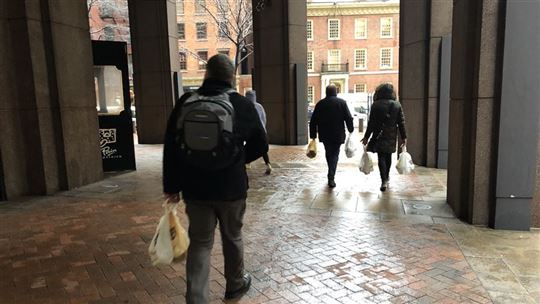
Salvo, who is now 57, discovered this bit by bit over time, and his life story deserves another article by itself. His roots are deeply Italian: he was born in Palermo and grew up in Milan, where he encountered the movement of CL and became so involved that he dedicated his life to it as a member of the Memores Domini. His story is also very American, with adventurous chapters filled with sudden changes of direction, highs and lows. He won a Green Card through the lottery and moved to the US in 1997. Then he returned to Italy and worked as a manager at the Mediterranean Institute for Transplants in Palermo. He returned to the US “in 2005, around the days of Fr. Giussani’s death: I had just enough time to attend his funeral, and then catch my plane.” He arrived at Benedictine College in Atchison, Kansas, and taught business for eight years. He had his life in the Memores Domini house, his students, and the movement, “but I slowly began to realize that something was missing, that I wanted to do something else.”
He began to understand what this something was almost by chance when he was back in Italy to spend the summer in Florence with his students. “There, simply, I came to understand the road. In Atchison, life was my house and the campus. In Florence, instead, I took the bus every morning to go into the city, and I met everyone–poor people, the disabled, volunteers, ex-prostitutes with small children... We got to talking, and they told me their stories. It opened a whole world to me.” This window opened even wider when he was in Subiaco, standing in front of a portrait of Saint Francis. The monk accompanying him said, “For Christianity, the passage from Benedict to Francis was a moment of change, more or less like what is happening today.” His words remained with Salvo. “I began to ask myself what this change meant for the church, for the movement, and for myself.”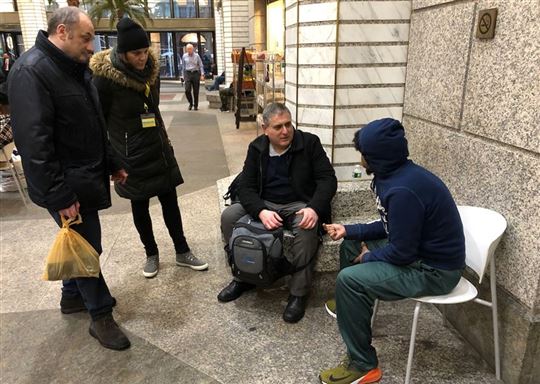
When he returned to America, he set out to learn more about the Franciscan charism. He met the Franciscan brothers in the Bronx in the summer of 2014 and spent a month with them in a homeless shelter. “There I discovered the homeless. I lived with 35 of them. I cooked and formed friendships. I proposed the School of Community, what I am. It was a moment of rediscovering our charism; until then I had lived from the head up, but there was a human aspect of things I had lost over time. I found it again in this period.”
Two subsequent encounters helped him even more. He had lost his job and was left with only “400 dollars, a pair of pants, and two shirts.” Outside of a church in Chinatown “there was a homeless man sitting on the sidewalk who couldn’t get his shoes on. I thought, ‘if a car passes it’ll kill him.’ So I asked him, ‘Do you need help?’ and he said, ‘Yes, I can’t get up.’ He was drunk. I put his shoes on him, then got him something to eat, and spent half an hour with him. In that short time he blossomed, and began telling me about himself and his wife. I thought to myself, ‘this is something that nobody else can do now. If I don’t respond to him, Who will be by his side?’”
That man outside the church was named Alan. “In fact, the mission began there,” and even more with Santiago, whom Salvo encountered some time later “in front of the same church, lying on the ground. He didn’t want help. I thought, ‘he doesn’t want to live anymore,’ and I told him that ‘I understand you, because I lost my job too, and I don’t know what to do.’ Santiago perked up and said to me, ‘Don’t worry. You’ll see, it’s not for ever...’ He began doing for me what I couldn’t do for him. I said to myself, ‘OK, maybe I’ve understood now.’ I could help him only because I was poor too. He found hope not because of what I gave him but because a relationship began between us. The entire mission of OCM began in that encounter.”
The rest followed easily, in small steps. There was an unexpected donation from an inheritance that showed up out of the blue and some of my friends got involved. It was enough to start tiptoeing into a world crowded with measureless humanity, almost as big as the many wounds that can drag a person down to life on the streets.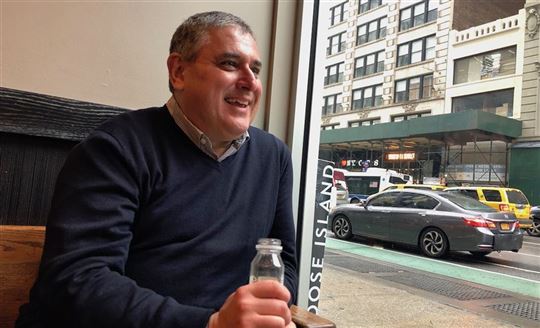
“There are roughly two types of homeless people,” Salvo explains, almost reluctantly, because it is clear that he doesn’t like categories. “The temporary ones are in need for economic reasons, like loss of work or illness. It’s very easy to go down from there. But these people stay on the streets a year or two, then they often succeed in getting back on their feet.” The chronic homeless are another story. “They’ve had a fracture in their life, mental illness, drugs, alcohol. And often their families don’t want them anymore, whether out of shame or because it’s truly impossible.”
There is another common feature of the homeless that Salvo sees all the time. “In these conditions, the human is reborn in an encounter–not as a result of your projects or because you want to evangelize them. The only thing you have to do is be willing to stay with them, just as they are. You have to love them, not love their ‘best interests.’ This is your project, what you have to do.” He says it took “five years of blood and tears to understand this. But what helped me the most was finding myself poor again, too,” an rediscovering himself as poor every time he encountered them. “While we have been talking, I have seen this man going back and forth. He picked up a suitcase, moved it, left it, and then went back inside with it. What is he looking for? I could be him. I am also disordered like him. Deep down, we all are.”
Salvo’s work involves pure gratuitousness. This can be seen in the encounters that happen repeatedly–sometimes you find them again in the same place; they begin to expect you and you become friends. Like C.J., who lived under a billboard at the entrance to the Staten Island Ferry station. “Every time we see him, in addition to food, he asks us for a pen and a notebook.” Or in the encounters in that last half an hour, like the one with Chantal on Fifth Avenue. “While I was chatting on my cell phone, she came up to me and said, ‘Why do people walk looking at their cell phones? We’re all crazy.’” They laughed and got to talking, and “she told me her whole story. When I said good-bye because I was going into the church there, she said, ‘Thanks, go and pray for me.’” That’s what the encounters on the street are like. “They begin with some unimportant comment, and end up on the personal level.” Or they overwhelm you with something they say. When Salvo asked Jong, from Thailand, sitting in his cardboard shelter built over a manhole cover, what he needed, Jong raised his eyes from the flashlight illuminating a book, and said, “Nothing. Maybe something for my heart.” “This is what they’re searching for: to feel loved, to be treated with respect,” one of the first OCM volunteers, Martha, told us one evening last winter while she was serving pea soup from a big pot set on a little table in front of the shelter on 28th Street. “You’d always like to do more. But God provides.”
“To do more.” This is a constant temptation for those who help out. Salvo says that they face it this way: “We chose not to rent a place to prepare food, not to buy a van to transport it, not to lock ourselves into a rigid structure. You do what you can with the means you have. Remaining poor is a privilege. It reminds us why we are with them and that we are not the ones who are responding to their need.” They never give money because “if you do, you put yourself on another level, superior. You become someone from whom they take something, someone who embarrasses them.” Asked what poverty is for him, Salvo says, “First of all, realizing that without the mercy of God I would not exist. Today, here.” This awareness also makes it easier not to get worried about numbers. “How many leave the street? I still don’t know about any total returns to normal life. I know about a lot of improvements, though, striking ones.”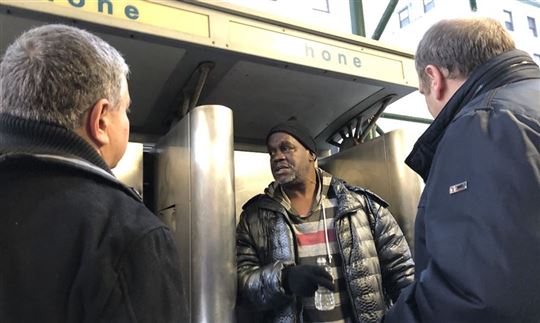
An example? John, “one of those with whom I became good friends.” When they met him, his feet were very dirty. “It disturbed me. I couldn’t sleep at night. I thought, ‘How is it possible for someone to live so dirtily in New York?’” One evening Salvo went to bring John food and saw that his hands, too, were dirtier than usual. “I asked him, ‘John, what happened?’ He asked, ‘Why?’ He began to look at them, and looked at them for five minutes. ‘They’re dirty.’ He hadn’t noticed it.” Weeks went by and they continued to meet. Then one day John told him, “This is the last time you’ll see me. I’m going to Las Vegas tomorrow. It’s hot there. I can’t stay here in the winter.” It turned out that the year before he was in California, and the year before that as well. “I asked, ‘But can you spend your whole life like this?’ He was quiet, thinking. I didn’t see him for a while. Then a few days later he called me. I thought he had already left. He said, ‘Hi, I need you to write me a letter of reference. If you do this, they’ll give me place to stay.’” Salvo went to talk to the social worker and they started the process. “This is the type of progress you see. Someone who first realizes that his hands are dirty, and then slowly decides to listen to you, who doesn’t run away anymore and asks for help. I don’t know where he is now, but he has my number and can call if he needs to. We can’t expect to remove the burden of a story that brought them to living on the streets. It’s not realistic. But what I desire is that within this unbearable burden there is an experience of hope.”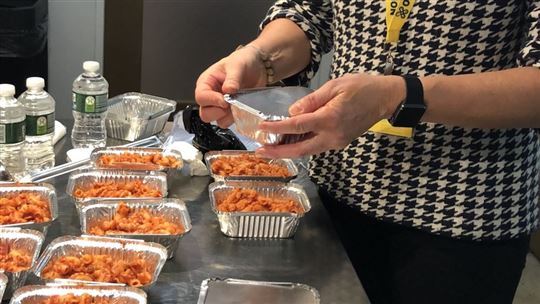
There are no demands, just “a benefit for yourself,” in the words of Alessandra, a recent arrival to the small group of people who spend their lunch hour every Thursday bringing the homeless of Battery Park some pasta cooked at the American headquarters of De Cecco in Lower Manhattan. “They give you a lot more than you give them.” Her group is one of four that in normal times go on certain days to Grand Central Station, or to Brooklyn, or outside the Church of Saint Francis of Assisi. Some are friends of CL, for whom OCM has become a charitable work. Many others are not, and have come through word of mouth. There is even a crew from the world of fashion, with models, actors, and photographers. “A friend who came last year with her husband was struck and threw a party. Some people from her world got involved.” After all, the name of OCM contains the words “One City,” a city for everyone. “We never thought of this mission as something only for the homeless. It’s for all of New York, especially for those with the greatest need–this is where we start, but it is for the city, so that the city can experience the human.”
Read also - Where are we now?
This is true for Doni, who goes monthly together with Raquel and Peter and other friends. She brings “pasta with ragu, so they get some meat,” about thirty containers at a time. She says there’s “a miracle in every encounter,” a miracle she did not expect when Salvo spoke to her about the OCM two-and-a-half years ago. “We were at dinner with friends of the Fraternity. He talked about this thing and was moved. I asked, ‘How can I help you?’ and he said, ‘Come.’ I said, ‘No, I can’t do it.’” But then she went, bringing nothing the first time. “We began to walk the route. Everyone introduced themselves and shook hands. They asked, ‘What do you have?’ and I didn’t have anything,” continues Doni with emotion. “At a certain point, someone asked, ‘Does anybody have a plastic bag?’ I always carry one in my purse; it’s a habit, and someone asked for exactly that, do you understand? I thought, ‘I’m that empty bag.’ From then on, I’ve never stopped going, bringing food, socks, and clothes. And I always carry an empty bag.”#CharitableWork #Coronavirus